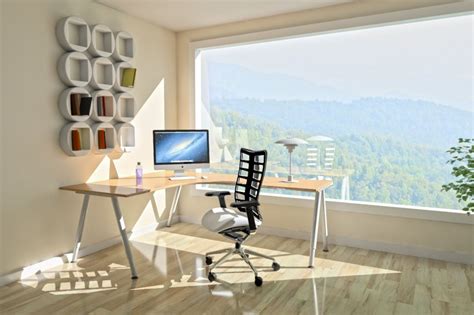In today’s fast-paced and hectic world, finding moments of peace and calm is more important than ever. One area where this is especially crucial is in the home office, where many of us spend a significant portion of our time. Creating a zen home office can not only help to increase productivity but also promote mindfulness and overall well-being. In this blog post, we will explore various ideas and tips for transforming your home office into a serene and mindful space. From choosing the right location to establishing routines for work-life balance, we will cover everything you need to know to create a peaceful and productive workspace. By incorporating natural elements, decluttering and simplifying the space, and designing for comfort and ergonomics, you can achieve a zen home office that promotes mindfulness and encourages a balanced work-life harmony. So let’s dive in and discover how to infuse tranquility and mindfulness into your home office space.
Choosing the Right Location
When it comes to creating a comfortable and productive living or work space, one of the most important factors to consider is choosing the right location. Whether it’s a home office, a living room, or a bedroom, the location of a space can greatly impact its functionality and overall ambiance.
When choosing the right location for a specific space, it’s important to consider factors such as natural light, noise levels, and accessibility. For a home office, for example, placing it in a quiet area of the house can help minimize distractions and improve focus. Natural light can also play a crucial role in creating an inviting and energizing environment, so positioning a workspace near windows or in a well-lit area can be beneficial.
In addition to considering practical factors, the emotional and psychological aspects of a space’s location should also be taken into account. For instance, a bedroom located in a peaceful and secluded area of the house can promote relaxation and better sleep. On the other hand, a living room positioned in a central and open area can encourage social interaction and a sense of connectivity.
Ultimately, choosing the right location for a space involves a thoughtful consideration of both the physical and emotional needs of the individuals who will be using it. By carefully selecting the location based on factors such as natural light, noise levels, accessibility, and the emotional impact, it’s possible to create a space that is not only functional and comfortable but also conducive to overall well-being.
Decluttering and Simplifying the Space
When it comes to creating a peaceful and harmonious living environment, decluttering and simplifying the space is a key step in the process. A cluttered and chaotic space can lead to feelings of stress and overwhelm, making it difficult to relax and unwind at home. By taking the time to declutter and simplify, you can create a more serene and tranquil atmosphere that promotes a sense of calm and well-being.
Start by going through your belongings and getting rid of anything that you no longer need or use. This could include old clothing, knick-knacks, or furniture that no longer serves a purpose in your home. Be honest with yourself about what you truly need and love, and let go of the rest. As you declutter, you’ll likely find that you feel lighter and more free, creating space for new opportunities and positive energy to flow into your life.
Once you’ve decluttered, it’s time to simplify your space by organizing and streamlining your belongings. Invest in storage solutions such as bins, baskets, and shelving to keep items neatly tucked away and out of sight. Consider adopting a minimalistic approach to decorating, opting for clean lines, uncluttered surfaces, and a cohesive color palette. By simplifying your space, you’ll create a more serene and peaceful environment that allows you to focus on what truly matters.
Remember, the key to decluttering and simplifying your space is to let go of anything that no longer serves you and to create a space that supports and nurtures your well-being. By doing so, you’ll create a home that is not only beautiful, but also promotes a sense of peace and tranquility in your daily life.
Incorporating Natural Elements
When it comes to designing a space, incorporating natural elements can have a significant impact on the overall ambiance and feel of the area. From a design perspective, integrating natural elements such as wood, stone, and plants can create a sense of warmth and tranquility in the space.
Incorporating natural elements also ties in with the current trend of biophilic design, which emphasizes the connection between humans and nature. This design approach can enhance well-being, productivity, and overall mood in a space, making it a valuable consideration when designing a home or workspace.
One way to incorporate natural elements is by using sustainable materials such as bamboo, cork, or reclaimed wood in furniture and decor. This not only adds a natural touch to the space but also aligns with eco-friendly design principles, which are becoming increasingly important in modern interior design.
Furthermore, adding indoor plants and greenery can bring life and a sense of freshness to any space. Whether it’s a small potted plant on a desk or a large statement plant in a corner, incorporating natural elements through greenery can contribute to a more vibrant and inviting atmosphere.
Designing for Comfort and Ergonomics
When it comes to creating a comfortable and ergonomic living space, it’s important to prioritize both physical and mental well-being. One of the key elements in designing for comfort and ergonomics is to choose furniture and decor that promote good posture and support the body’s natural movements. This means investing in chairs, desks, and other pieces that are adjustable and supportive, and also taking into consideration the layout of the space to allow for easy movement and flow.
Additionally, incorporating elements such as soft textiles, cozy lighting, and temperature control can contribute to a comfortable and relaxing environment. These small details can make a big difference in creating a space that is inviting and promotes a sense of well-being. Furthermore, creating designated spaces for relaxation and mindfulness within the home can help to reduce stress and improve overall comfort and ergonomics. This could include a meditation corner, a cozy reading nook, or a comfortable seating area for quiet reflection.
Another important aspect of designing for comfort and ergonomics is to consider the impact of technology on our daily lives. Through the integration of ergonomic tools, adjustable monitor stands, and other tech-friendly solutions, it’s possible to create a space that supports productivity and comfort in the digital age. By prioritizing the well-being of the body and mind when designing a living space, it’s possible to create a home that promotes health and happiness.
In summary, designing for comfort and ergonomics involves thoughtful consideration of furniture, layout, and environmental factors to create a space that supports physical and mental well-being. By prioritizing comfort and ergonomics in the design process, it’s possible to create a home that is both functional and inviting, and that promotes a sense of peace and relaxation.
Creating a Calming Color Palette
When it comes to designing a space that promotes relaxation and tranquility, one of the most important factors to consider is the color palette. Choosing the right colors can have a significant impact on the overall ambiance of a room. Soft, muted tones such as pale blues, gentle greens, and subtle grays are known for their calming effects, making them ideal choices for creating a serene environment.
In addition to the actual hues themselves, the placement of these calming colors within the space is also crucial. For example, using these soothing tones on walls, furniture, and decor can help to create a cohesive and peaceful atmosphere. Simplicity is key when it comes to a calming color palette – too many bold or conflicting colors can create visual clutter and disrupt the sense of calm.
Another element to consider when incorporating a calming color palette is lighting. Natural light can enhance the soothing effects of a soft color scheme, while harsh or artificial lighting can detract from the peaceful ambiance. It’s important to consider how different light sources will interact with the chosen colors, and to make adjustments as needed to maintain the desired calming effect.
Ultimately, creating a calming color palette involves careful consideration and intention. By choosing the right colors, placing them strategically, and considering their interaction with light, it’s possible to design a space that promotes relaxation and tranquility.
Integrating Mindful Decor and Inspirational Quotes
When it comes to creating a peaceful, harmonious living space, the devil is in the details. Integrating mindful decor and Inspirational quotes can help to infuse your home with a sense of tranquility and positivity.
One way to incorporate mindful decor is by choosing pieces that have a special meaning to you. Opt for decor items that reflect your values, beliefs, and personal journey. Whether it’s a piece of art that resonates with you or a hand-crafted item that holds sentimental value, surrounding yourself with meaningful decor can bring a sense of mindfulness to your space.
Inspirational quotes can also play a powerful role in shaping the ambiance of your home. Whether it’s a quote that encourages self-love, resilience, or gratitude, strategically placing these words of wisdom throughout your home can serve as gentle reminders to stay present and focused on the positive aspects of life.
By integrating mindful decor and inspirational quotes into your living space, you can create an environment that nurtures your well-being and fosters a sense of inner peace.
Establishing Routines for Work-Life Balance
Establishing a healthy work-life balance is essential for overall well-being and happiness. With the demands of work, it can often feel like there is no time to focus on personal life or self-care. However, incorporating routines into your daily life can help create a sense of structure and stability, allowing for a better balance between work and personal time.
One important routine to establish for work-life balance is setting boundaries for work hours. This means clearly defining when your workday begins and ends, and sticking to those times as best as possible. By doing so, you can avoid the temptation to overwork and ensure that you have dedicated time for relaxation and personal activities.
Setting daily priorities is another important routine to help achieve work-life balance. This involves creating a list of tasks for each day and prioritizing them based on their importance. By focusing on the most important tasks first, you can ensure that you are not spending unnecessary time on less critical projects, allowing for more time to relax and enjoy personal activities.
Finally, incorporating mindful practices into your daily routine can greatly contribute to establishing work-life balance. This can include activities such as meditation, yoga, or simply taking time to reflect on the day. By scheduling these practices into your daily routine, you can create a sense of calm and mindfulness that can help reduce stress and improve overall well-being.





